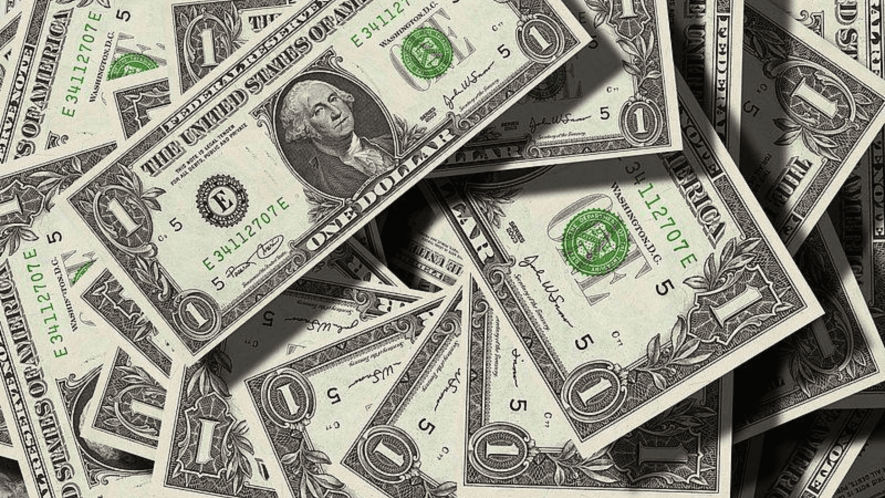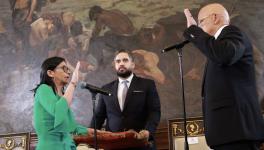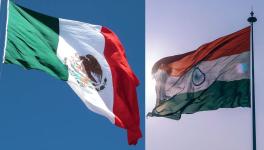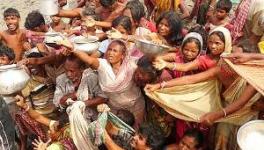The Perilous Path from Western Domination to De-Dollarisation

Dollar. Image Courtesy: Wikimedia Commons
Two interesting things happened at the BRICS summit in South Africa in August. Several new members were invited to join BRICS in 2024: Argentina, Egypt, Ethiopia, Iran, Saudi Arabia, and the UAE. And, at Brazil’s urging, a commission was established to study the possibility of a new currency to replace the dollar in international trade. Currency swap agreements will continue to be the way the process moves forward in the short term, though, because the dollar cannot be replaced in a rush.
To escape the shackles of dollarisation, Global South countries have a perilous path to walk. The major problems, as described by political economists Michael Hudson and Radhika Desai, are as follows: Global South countries are saddled with immense debts in dollars, and Western corporations claim ownership over their resources. The international legal structure favours the West, finding in favour of American corporations and vulture funds. The U.S.-run covert network continues to have the ability to foment wars and coups against those who defy Western rules—including financial ones. These problems now confront most countries of the world.
Thus far, most of the world is not polarised. Very few countries (mostly in Europe) are unconditional supporters of the U.S.-led West. On the other side, only a handful of states (e.g. Russia, China, Iran) dare to categorically refuse when the West makes demands.
Everyone else—where the future of the global economy will play out—is in-between. Will they find a way out of these traps?
Argentina’s Politicised Debt
For about 200 years, Argentina has been the site of first British, and then U.S. experiments in debt-driven subjugation. Each time a developmentalist government came to power and tried to get the country out of a crisis, it would be followed by a right-wing government that would plunge the country back in.
Among the in-between countries, Argentina has a special role. The country is on the list of the new invitees to BRICS. Its finances are in disarray, and its leading presidential candidate, who takes economic advice from his four dogs, wants to close most of the government down and use the U.S. dollar as the currency. Like many right-wing Western politicians, from Berlusconi and Sarkozy to Trump and Bolsonaro, Milei’s electoral brand is damaged neither by clown antics nor by infeasible economic plans.
And infeasible they are. The Economist notes that “Milei promises cuts worth 15 [percent]… of GDP, to a public sector that accounts for 38 [percent]… of GDP, but struggles to outline where they will come from.”
Nor does he know “how… Milei’s government would find the $40 [billion] his team thinks is necessary to make the switch to dollars. Currently, Argentina cannot even repay the [International Monetary Fund (IMF)]… to which it owes $44 billion. Having run out of American currency, the central bank is instead burning through yuan borrowed from China… Milei has suggested selling state-owned firms and government debt in an offshore fund to raise the necessary capital. It is hard to imagine there will be many buyers.”
Argentina’s fate has been controlled by imperial debt since 1824 when the British Empire’s bank (Barings—whose Lord Cromer used financial methods to take over Egypt, among other notable operations) first advanced a loan of one million pounds to newly independent Argentina. This was less than 20 years after the British landed forces to try unsuccessfully to colonise Argentina. They ultimately found the financial weapon more effective. The first of nine defaults followed in 1827. The latest was in 2020 (the Economist is advocating a tenth).
In the 20th century, Argentina alternated between elected governments and military dictatorships and switched between developmentalist and neoliberal economic approaches. In the neoliberal periods, Argentina was the site of innovation—new experiments in plundering a country were invented. Among these was what Esteban Almiron outlined as the “financial bicycle” made possible by the peg of the peso to the U.S. dollar:
“When billionaire speculators were allowed to exchange Argentine pesos for unlimited amounts of dollars, benefiting from [high-interest]… rates in pesos, it was the state that had to borrow those dollars from [U.S.]… private banks or from the IMF and pay interests on them. Once exchanged, the dollars obtained by the speculators were moved out of the country, leaving the debt to the state.”
In 2001, Argentina defaulted and dropped the peg. It then paid its $9.5 billion IMF debt in full in 2005, saving the country $842 million in interest in subsequent years. It also negotiated, through to 2010, a restructuring of 92% of the rest of the national debt.
Almiron’s history of Argentina’s debt describes what happened next: a story of Argentina and the American vultures. The remaining 8% of the debt offers a case study of the rigged international legal structure that facilitates the U.S. plunder of Global South economies. It was held by vulture funds run by American billionaire Paul Singer and others. The vultures turned to the U.S. courts and, predictably, in 2012, got exactly what they wanted—a U.S. judge ruled that Argentina would have to pay them in full.
Then-president Cristina Fernández de Kirchner refused to pay, but subsequent elections brought Mauricio Macri into power. Macri increased Argentina’s debt-to-GDP ratio from 52.6% to 90.2% and oversaw an increase in poverty from 30% to 40% (four million people entering poverty). By the time he left power in 2019, Argentina had experienced $79.8 billion in capital flight—and defaulted again. Almiron writes that “Macri and his team wrecked the relatively healthy finances of the Argentine state in less than two years.” Macri brought back the financial bicycle:
“Their trick was to buy pesos, profit from the [high-interest]… rates in pesos, then convert them to dollars and move the dollars out of the country. In the meantime, the state had to provide a virtually infinite amount of dollars for the speculators, and was left with the pesos.”
On his way out the door, Macri took out a $57 billion loan from the IMF, later reduced to $44 billion, which “disappeared in just 11 months.”
His successor Alberto Fernández tried to rebuild the gutted health ministry during COVID-19 but was stuck with the $44 billion loan. Out of desperation as much as out of developmentalist ideology, Fernández turned to China, joining the Belt and Road Initiative in 2022 and applying—successfully, it turns out—to BRICS. Argentina will join in 2024. However, collaboration with China (and Qatar) so far has been a matter of getting additional loans from China to pay the IMF. This is not exactly the type of “win-win” deal China seeks with Global South countries in its infrastructure investments and trade deals around resources.
If elected, Milei can be expected to withdraw the BRICS application. If he keeps Argentina in BRICS, he will apply his (and his dogs’) financial genius to facilitate the U.S. use of Argentina not just to drain Argentina, but China (and perhaps other emergency lenders) as well.
With each new plunge into debt, the country’s right-wing attempts to sink the state so much deeper that it can never emerge. When he arrives in office, dog whisperer Milei has promised to outdo Macri’s record of destruction.
The Travails of Pakistan, Ally of Both the U.S. and China
Like Argentina, Pakistan has been controlled by imperial debt regimes—first British, then U.S.—for centuries. What is now Pakistan was once a group of rich provinces in British India. Each kingdom that Britain’s East India Company brought under its boot was saddled with debt, the principal mechanism (there were others) through which Britain drained $45 trillion from the subcontinent. Britain then partitioned the subcontinent into India and Pakistan before handing it over. Today India is playing an ambiguous role in BRICS, while Pakistan’s post-coup government has resorted to severe violence to try to get the country under control.
Also like Argentina, Pakistan is a place where both BRICS and the IMF have a heavy economic presence. In April, about a year after former Prime Minister Imran Khan was ousted, the U.S. Institute for Peace reported that Pakistan was facing an “existential” economic crisis. Dividing the debt into three types (multilateral, private, and Chinese), the USIP gave a breakdown of Pakistan’s debt and to whom it was owed: “As of December 2022, Pakistan holds external debt and liabilities of $126.3 billion. Nearly 77% of this debt, amounting to $97.5 billion is directly owed by the government of Pakistan to various creditors; an additional $7.9 billion is owed by government-controlled public sector enterprises to multilateral creditors.”
Pakistan’s multilateral debt of $45 billion broke down as follows: the World Bank ($18 billion), the Asian Development Bank ($15 billion), and the IMF ($7.6 billion), with smaller amounts to the Islamic Development Bank and the Asian Infrastructure Investment Bank. It owes another $8.5 billion to major creditor countries Japan, Germany, France, and the United States.
Pakistan’s private debt was led by Eurobonds and global Sukuk bonds, amounting to $7.8 billion. It also had foreign commercial loans to the tune of nearly $7 billion, likely to increase to nearly $9 billion by the end of the current fiscal year.
Finally, the USIP placed the “Chinese debt” of $27 billion in a separate category:
“This includes around $10 billion of bilateral debt and $6.2 billion in debt provided by the Chinese government to Pakistani public sector enterprises, and Chinese commercial loans of around $7 billion. In addition, China’s State Administration of Foreign Exchange (SAFE) has placed $4 billion worth of foreign deposits with Pakistan’s central bank.”
With a GDP of $376 billion and a debt of $126 billion in 2022, Pakistan’s debt-to-GDP ratio of 34% is much more favourable than Argentina’s even before the Macri disaster. Still, Pakistan’s Western creditors presented it as an impossible situation and inflation was indeed causing popular hardship.
The 2022-23 government budget projected revenues of $24 billion and expenses of $33 billion. Debt repayments, not factored in, were looking like they would exceed state revenues, at almost $25 billion.
The Chinese debt could be rescheduled as per historical precedent—but it was only 30% of the total. What about the rest? Over the decades, Argentina’s developmentalist governments tried to use economic growth to raise the tax and export base to shrink the debt when in power, but Pakistan’s growth forecast wasn’t looking good. Likewise, in the long-term, as documented in Jawad Syed and Yung-Hsiang Ying’s 2020 book China’s Belt and Road Initiative in a Global Context Volume II: The China Pakistan Economic Corridor and its Implications for Business, the CPEC envisions upgrading Pakistan’s value chains and infrastructure as a process of economic development for both countries.
But what about the short term? Pakistan tried to get creative: Prime Minister Imran Khan had just struck a deal for energy and wheat—the two most necessary and inflationary items in the basket—from Russia when he was ousted. The post-coup government scuttled the deal, trying to avoid trouble with the U.S. for trading with U.S.-sanctioned countries outside of dollar transactions. Pakistan took a page out of pre-Nixon-visit China’s book and used barter. But the Western creditors are still there, demanding to be paid (in dollars). Whether by downgrading Pakistan’s credit rating or monitoring and punishing Pakistan as a financial sponsor of terrorism through the Financial Action Task Force (FATF), the United States has many tools to force debt compliance on Pakistan.
How did the situation get so dire? Pakistan’s finances, including its U.S. debts, are tied up in the two countries’ web of covert relationships and the interventions of both countries in Afghanistan since the 1970s. Sure, the United States and Pakistan trade cotton and textiles, steel and machinery, but the heart of the economic relationship is martial. The people of Afghanistan suffered the worst, with author Nicolas J.S. Davies estimating a death toll of 875,000, but Pakistan too suffered. Pakistan’s intervention in Afghanistan and U.S. operations in rural Pakistan cost the U.S. ally $150 billion and 70,000 lives according to the Pakistani ambassador to the United States in 2021 and 325,000 deaths according to Davies.
The amount of money the United States spent on the Afghan occupation is immense and probably uncountable. There are official accounting numbers of $100 billion in military contracts alone. Columnist Khawaja Akbar quipped that if Pakistan was passing military aid money onto the Taliban, it could only be a fraction of what the United States spent: “The $1 trillion spent by the U.S. in Afghanistan during the same time period failed to negate the effect of the $30 billion given to Pakistan.”
When Imran Khan ended support for the U.S. effort in Afghanistan, the occupation’s days were numbered: U.S. logistics for the 2001-2021 Afghan war all ran through Pakistan. A New York Times article published shortly after the Taliban takeover noted “Pakistan’s ports and airfields provided the main entry points and supply lines for American military equipment needed in Afghanistan.” American occupation logistics were a touchy issue and the U.S.-Pakistan relationship broke down over it numerous times.
Tariq Ali wrote of one such moment in his 2008 book, The Duel:
“The country is in the grip of a food and power crisis. Inflation is approaching 15 [percent]… The price of gas (used for cooking in many homes) has risen by 30 [percent]… and the price of wheat by more than 20 [percent]… since November 2007. Food and commodity prices are rising all over the world, but there is an additional problem in Pakistan: too much wheat is being smuggled into Afghanistan to feed the NATO armies. According to a recent survey, 86 [percent]… of Pakistanis find it increasingly difficult to afford flour, for which they blame their new government. [Former president Asif Ali] Zardari’s approval rating has plummeted to 13 [percent].”
There is no discussion of the smuggling economy in Pakistan and Afghanistan without mentioning opium. It was an economy of literally uncountable riches, maybe $2 billion, maybe much more, for U.S.- and Pakistan-based covert organisations, criminal organisations, and financial institutions that the Taliban has put an end to.
When the United States stole Afghanistan’s $7 billion in reserves after the Taliban takeover, Pakistan also suffered as the country’s major trading partner.
During the decades of Afghan wars, the United States and Pakistan developed dossiers full of secret leverage on one another—so much so that after invading Afghanistan in 2001, the United States made sure Pakistan was able to get its most important operatives out. This operation would later be called the “airlift of evil.” by the United States.
We can summarise this as follows: Over the course of the U.S. war on Afghanistan, Pakistan ran up an immense covert expense bill, an immense death toll, and an illicit, parallel economy that only harmed the formal economy.
After the Taliban takeover and Imran Khan’s ouster, the United States would resume this web of covert relationships with Pakistan—not over Afghanistan this time, but Ukraine. According to the Intercept, Pakistan’s post-coup IMF negotiations were smoothed by a secret agreement to produce munitions for the United States—munitions the United States would then send to Ukraine to fight Russia. Needless to say, had Imran Khan’s wheat-energy deal with Russia gone through, Pakistan probably would not be sending munitions for the Ukrainian side of the war.
Other Cases
Between Argentina and Pakistan, many of the dilemmas of the dollar-dominated and the post-dollar world are encapsulated. But a quick tour of some other states reveals some other dynamics. The IMF wants Egypt (another new BRICS invitee) to devalue; Egypt’s president, who came to power in a coup a decade ago, is stretching the negotiations out. Keeping Egypt out of a revolutionary situation is how the United States provides for Israel’s security, so expect those negotiations to keep dragging on. In Lebanon, the IMF strategy is different—keeping Lebanon in a state of financial collapse is another plank of the U.S./Israeli strategy, so as with Argentina, the objective is an unending financial crisis. So far, mission accomplished. Tunisia has been pillaged by neocolonial debt arrangements since the 19th century. This continues uninterrupted. Sri Lanka, devastated by the tsunami of 2004, became a recipient of IMF-led predatory lending from that point on. Even though just 10% of this debt is owed to China, Sri Lanka is referred to in the West as being caught in a “Chinese debt trap.” In fact, because so little of the debt is Chinese, Sri Lanka is fairly straightforwardly in a Western debt trap from which it will have difficulty escaping.
A couple of final cases to conclude: In Kenya, the IMF is pressuring hard, demanding more suffering from Kenyans in the form of higher taxes and lower spending—the usual austerity measures. Kenyan authorities announced earlier this year they aren’t going to try to reschedule or restructure. Kenya is also the site of one of the flagship China-Africa projects, the Mombasa-Nairobi Standard Gauge Railway (SGR), along with other infrastructure. On the other hand, a U.S. Africa Command (AFRICOM) military base is also in Mombasa. Zambia, lucky enough to owe $4.1 billion of its $6.3 billion debt to China, restructured in June. Naturally, the IMF claimed this as a triumph for its own flexibility and long-term vision, claiming the agreement was “helping put Zambia on a path toward sustainable economic growth and poverty reduction.” France’s President Emmanuel Macron also took credit for the “historic achievement”: “We remain [mobilized]… to ensure that other countries caught in a debt trap benefit from a multilateral response,” he tweeted.
In all of these cases, the U.S. and IMF are careful to pressure only when they hold the cards. When China holds a big share of the debt or can offer a meaningful alternative, the IMF also seems to find a way to be less haughty with its debtors. The IMF needs to tread lightly as well: they are no longer the only game in town, and negotiating too hard in the presence of alternatives will lead to default—perhaps the IMF’s last.
In summary: De-dollarisation is a road fraught with many challenges. Most countries are not the world’s biggest economy (China) nor the military peer of the United States (Russia). Few countries fall into the category of Iran, Venezuela, Cuba, Afghanistan, and the DPRK—those who have suffered everything the United States can realistically throw at them and have nowhere to go but up.
Most are like Argentina and Pakistan, in the in-between of economic suffering, perils, and difficult decisions. Extricating themselves from Western power will be painful, but no longer appears impossible.
This article was produced by Globetrotter. Justin Podur is a Toronto-based writer and a writing fellow at Globetrotter. You can find him on his website at podur.org and on Twitter @justinpodur. He teaches at York University in the Faculty of Environmental and Urban Change.
Get the latest reports & analysis with people's perspective on Protests, movements & deep analytical videos, discussions of the current affairs in your Telegram app. Subscribe to NewsClick's Telegram channel & get Real-Time updates on stories, as they get published on our website.
























